- Table of Content
- 1.Single Event U...
- 2.PROBA2/LYRA's ...
- 3.The speakers o...
- 4.Review of Sola...
- 5.International ...
- 6.PROBA2 Observa...
- 7.Noticeable Sol...
- 8.Geomagnetic Ob...
- 9.Review of Iono...
- 10.The SIDC Space...
- 11.Upcoming Activ...
2. PROBA2/LYRA's New Data Product
3. The speakers of the Wetenschapsbattle 2026 are selected
4. Review of Solar and Geomagnetic Activity
5. International Sunspot Number by SILSO
6. PROBA2 Observations
7. Noticeable Solar Events
8. Geomagnetic Observations in Belgium
9. Review of Ionospheric Activity
10. The SIDC Space Weather Briefing
11. Upcoming Activities
Single Event Upset
SUMMARY - An inflight incident with an Airbus 320 on 30 October was most likely triggered by the impact of a high-energy particle resulting in an uncalled Single Event Upset ("bit flip"). The required soft- and/or hardware patch grounded 6000 aircraft. This article provides background information on the recall and triggering incident, as well as the relevant spaceweather information. Links to the various info sources can be found in the online version of this article at https://www.stce.be/news/797/welcome.html
Recent recall of the Airbus A320 fleet
On 28 November 2025, Airbus issued an emergency global recall of around 6000 of its A320-family aircraft - roughly half of the world's in-service Airbus fleet (Airbus communication). The action followed an inflight incident on 30 October 2025 affecting JetBlue Airways Flight 1230 (A320), which experienced a sudden, uncommanded "pitch-down" while cruising from Cancún (Mexico) to Newark (USA). The aircraft rapidly lost altitude before the autopilot recovered, and the plane was safely diverted to Tampa, Florida. At least 15 passengers reportedly suffered injuries of various severities and required hospitalization.
Airlines operating A320-family jets worldwide - from U.S. carriers to European, Asian and Latin American airlines - were affected by the recall. In the United States, the recall happened just prior to Thanksgiving, with the delays and cancellations frustrating the passengers. Even an ITA Airways Airbus A320neo aircraft operating the first international journey undertaken by Pope Leo XIV was confined to ground until it had undergone the necessary modifications before returning again to service (NC Register).
By 1 December 2025, the vast majority of the A320s had already been updated or reverted to a safe software version; only a small minority - fewer than 100 jets - remained grounded awaiting the final fixes.

Source of the recall: the JetBlue 1230 incident and spaceweather context
The triggering event for the recall was the JetBlue 1230 flight incident that occurred on 30 October 2025. The root cause was traced to a failure in the A320's flight control computer, specifically the Elevator and Aileron Computer (ELAC). According to investigators, during the incident the ELAC 2 module recorded a sudden, uncommanded elevator deflection resulting in a dramatic descent. Cruising at 35000 feet altitude with the autopilot engaged, at 17:48 UTC the aircraft experienced an uncontrolled pitch-down event for about 4-5 seconds before autopilot corrected. This resulted in a sudden loss of altitude (about 100 feet), upon which the aircraft made an emergency landing at Tampa, Florida 30 minutes later (Aviation Safety Network).
Airbus analysed multiple scenarios on possible causes of this event using their advanced development test simulator. This simulator is coupled with real aircraft components (computers, hydromechanical components, ... ). The result led the investigation team to rule out all scenarios, except the potential impact from a Single Event Upset caused by radiation. Indeed, high-energy particles can trigger a Single Event Upset (SEU) in an aircraft or a satellite by penetrating onboard electronics and flip bits (a "0" becoming "1" or vice versa) in digital circuits, as shown in the ESA sketch underneath. Based on this information, and with safety as their top priority, Airbus took the action to require software changes on affected aircraft, in full liaison with the airworthiness authorities.
In its public communication (Airbus communication), Airbus indicated that "intense solar radiation" (e.g., from solar energetic particles) may corrupt flight control data - a vulnerability not fully considered in the original certification. Because the failure was attributed to radiation-induced "Single Event Upsets" (SEUs) in micro-electronics, many commentators immediately looked into spaceweather data to assess whether the solar environment on 30 October was unusually hostile. Indeed, SEUs are more directly linked to proton events, i.e. bursts of high-energy particles, that occasionally occur during intense solar flares. As no proton event was in progress late October, most radiation-and-spaceweather experts suggest that the root cause was more likely a high-energy cosmic ray - not sunlight or a solar proton storm - striking the ELAC memory and flipping bits.
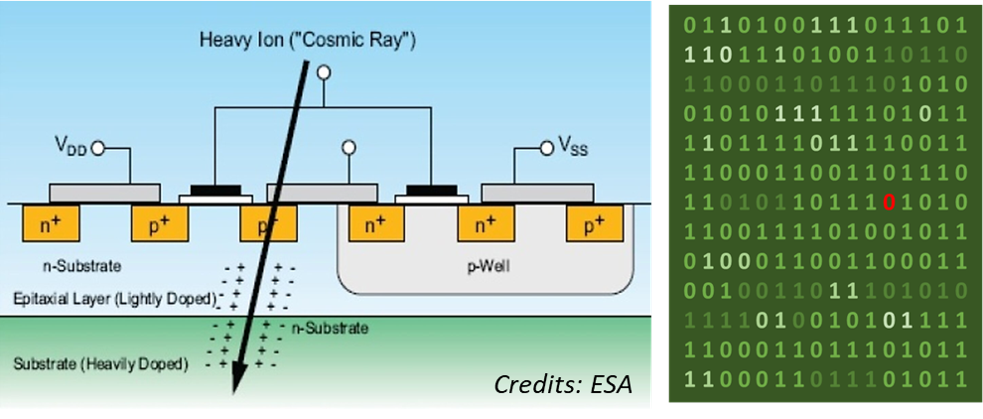
Comparison with Qantas 72 (2008)
This is not the first time an "uncommanded pitch-down" has afflicted a modern Airbus fly-by-wire jet. For example, on 7 October 2008, Qantas Flight 72 - an Airbus A330, so a different type than the A320 - experienced a violent descent over the Indian Ocean, injuring over 100 passengers. Investigators from the Australian Transport Safety Bureau (ATSB) deemed a SEU extremely unlikely, and concluded in their final report (issued December 2011) that the incident "occurred due to the combination of a design limitation in the Flight Control Primary Computer (FCPC) software of the Airbus A330/A340, and a failure mode affecting one of the aircraft's three Air Data Inertial Reference Units (ADIRUs). The design limitation meant that in a very rare and specific situation, multiple spikes in AOA (angle-of-attack) data from one of the ADIRUs could result in the FCPCs commanding the aircraft to pitch down." (ATSB)
In the Qantas 72 case, the ADIRU produced intermittent erroneous AOA data spikes; two spikes spaced about 1.2 seconds apart fooled the flight control computers into thinking the aircraft was stalling, prompting an automatic nose-down command. After the incident, Airbus redesigned the FCPC AOA-processing algorithm and modified ADIRU hardware to prevent recurrence (ATSB).
Thus, both the 2008 and 2025 incidents share a common underlying vulnerability: rare, unexpected faults in flight-data systems (whether ADIRU in 2008, or ELAC in 2025) that produce erroneous data, leading to dangerous automated control responses. But while the Qantas 72 failure was related to internal software issues and hardware limitations, the JetBlue/A320 case was rooted in external radiation interacting with micro-electronics, which is a fundamentally different trigger.
Influence of the 11-12 November 2025 solar storm
Some two weeks after the JetBlue incident, on 11 November 2025, the Sun unleashed a powerful solar eruption: an X5 flare from sunspot region NOAA AR 14274 associated with a coronal mass ejection (CME) and intense proton event (see the STCE newsitems). This proton event triggered a rare Ground Level Enhancement (GLE), meaning that the solar protons were so energetic that they created secondary particles such as neutrons in the upper atmosphere which in turn showered down to the Earth's surface where they were detected with neutron monitors (see sketch underneath). This was only the 77th GLE recorded since systematic measurements began in the 1940s (see the University of Oulu for an overview).

Atmospheric monitoring during the storm (e.g., via balloon-borne sensors developed by the University of Surrey and operated by the UK Met Office and the KNMI) detected radiation dose rates at typical commercial flight altitudes (about 12 km / 40000 ft) rising to nearly ten times the normal dose rate from the regular cosmic ray background - the highest levels at aviation altitude in almost 20 years (see also the AVIDOS dose rate map underneath). High-latitude transatlantic routes likely received roughly twice their normal cosmic ray dose during the peak of the event (The Watchers ; Spaceweather.com). That's not enough radiation to cause a health emergency for passengers, but it was a concern for avionics. Radiation experts at the UK Met Office (among others) noted that during the peak of the November storm, Single Event Upsets in aircraft memory modules could reach "around 60 errors per hour per gigabyte" (University of Surrey). While this does not necessarily cause a crash on its own, bit flips in critical flight control computers like ELAC can - if not properly mitigated - produce errors like those observed on JetBlue 1230.
Although this November storm dramatically illustrated how severe solar events can elevate atmospheric radiation and therefore increase the risk of SEUs in aircraft electronics, it occurred after the JetBlue incident and before the results of the initial investigation into it were known. So, the storm itself did not trigger the grounding of the A320 fleet, nor was it causally linked to Flight 1230. Nonetheless, the storm underlines a growing concern for aviation: as the Sun is still near maximum activity in its current solar cycle 25, the chance on a (more) intense solar particle event (SPEs) that can flood the atmosphere with high-energy protons which are capable of corrupting avionics, is real. It is a sobering thought that the intensity of the 11 November event is only a fraction of that of the largest solar radiation storm on record in 1956, and that this 23 February 1956 event itself is dwarfed by the so-called "Miyake events", extremely strong radiation events that occur only once every 1000 to 10000 years (STCE newsitem ; Cliver et al. 2022).
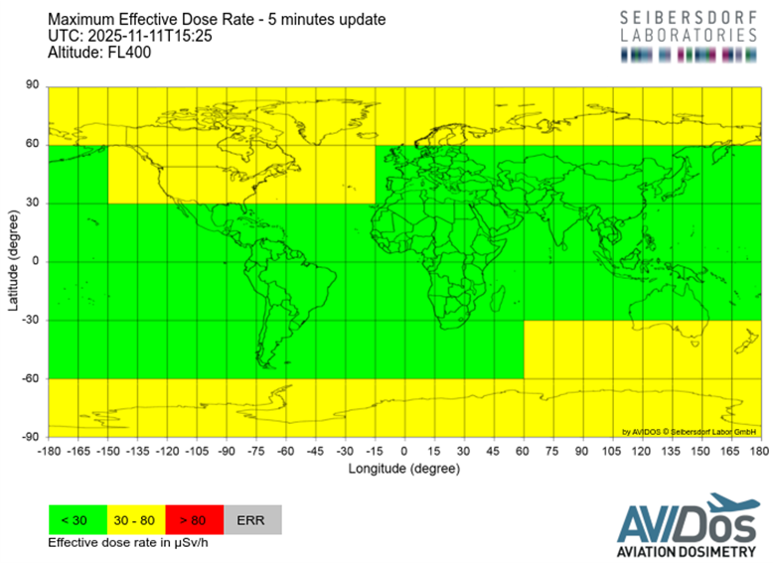
Conclusions
The 2025 recall of roughly 6000 A320-family jets represents one of the most sweeping safety measures in modern commercial aviation. The precipitating event - the sudden pitch-down on JetBlue Flight 1230 - exposed a critical vulnerability in the ELAC flight control computer to radiation-induced data corruption. While Airbus publicly cited "intense solar radiation", the lack of any documented major solar flare or proton event on 30 October makes a cosmic ray induced Single Event Upset the most plausible root cause.
A comparison with the 2008 Qantas Flight 72 incident underscores that pitch-down failures in fly-by-wire aircraft are not new; what is new in 2025 is the scale of the affected fleet, and the involvement of spaceweather threats rather than internal soft- or hardware bugs.
The powerful solar storm of 11-12 November 2025 - though unrelated to the JetBlue incident - demonstrated that the atmospheric radiation environment at cruising altitudes can, under extreme conditions, surge to levels at least an order of magnitude above normal cosmic ray background. Such events significantly raise the risk of SEUs in aircraft electronics. As solar activity remains at high levels during the current solar cycle maximum, it seems good practice to harden critical avionics against particle-induced bit flips through technical hard- and software improvements, applying redundant systems as well as using real-time spaceweather monitoring.
PROBA2/LYRA's New Data Product
Since 2010, the radiometer LYRA onboard the ESA satellite PROBA2 has been observing the Sun in extreme ultraviolet (EUV) and soft X-ray wavelengths. For almost one and a half solar cycles, LYRA has produced a vast amount of data in high temporal resolution, e.g. more than 28 000 flares. But the data include also values (the daily minimum outside flares) which correspond to long-term solar behaviour related to the development of active regions and sunspots. Meanwhile, the LYRA team has learned to discern the different instrumental degradation of quiet-Sun, active-region, and flare signals, and how to individually correct it.
LYRA consists of three similar instrumental units, of which the “nominal” unit is observing all the time with its cover open, while the “calibration” unit is rarely used, its cover mostly closed, and that unit is thus almost not degraded. Degradation is caused by UV-polymerization, which leads to a molecular contamination on the first optical surface. All LYRA units consist of four channels with different spectral intervals; the two shorter-wavelength channels use an Aluminium filter to observe a range 17-80nm as well as below 5nm, and a Zirconium filter to observe a range 6-20nm as well as below 2nm. By comparing the active-region signal of these two channels in the much-used “nominal” unit and the rarely-used “calibration” unit over time, the correction factors between First Light in 2010 and the present can be calculated.
The performance of these two PROBA2/LYRA channels and its degradation correction is described in detail, and the correlation with two other values (GOES SXR, sunspot numbers) is demonstrated here: https://www.sidc.be/users/dammasch/IED_20250918_LyraDataset.pdf
The LYRA team wants to present this 15-year daily dataset to the solar community, in order to enable a comparison with various solar indicators, and to study the solar cycle.
The 2010-2025 daily LYRA long-term solar levels before correction can be found here as ASCII text file: https://proba2.sidc.be/lyra/data/LyraRescaled/2025/LyraBackground.txt
After correction, the file can be found here: https://proba2.sidc.be/lyra/data/LyraRescaled/2025/LyraBackCorrect.txt
These two files are regularly updated, i.e., the most recent day(s) are added. The file LyraBackCorrect.txt is the new data product. The file LyraBackground.txt replaces the old version LyraBackground_yyyymmdd.txt which is no longer produced.
Figure 1 below shows the two channels of the nominal LYRA unit, plus GOES values and sunspot numbers before correction. Figure 2 shows the same after correction.
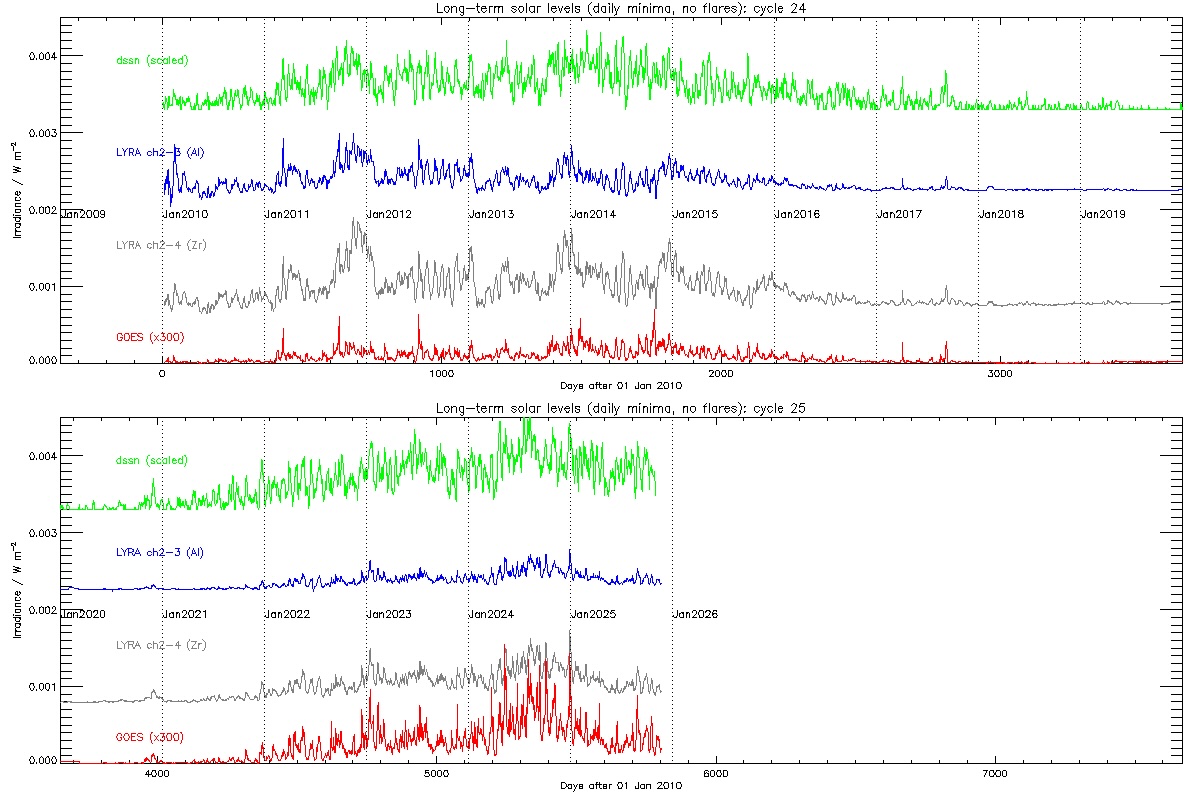
Figure 1
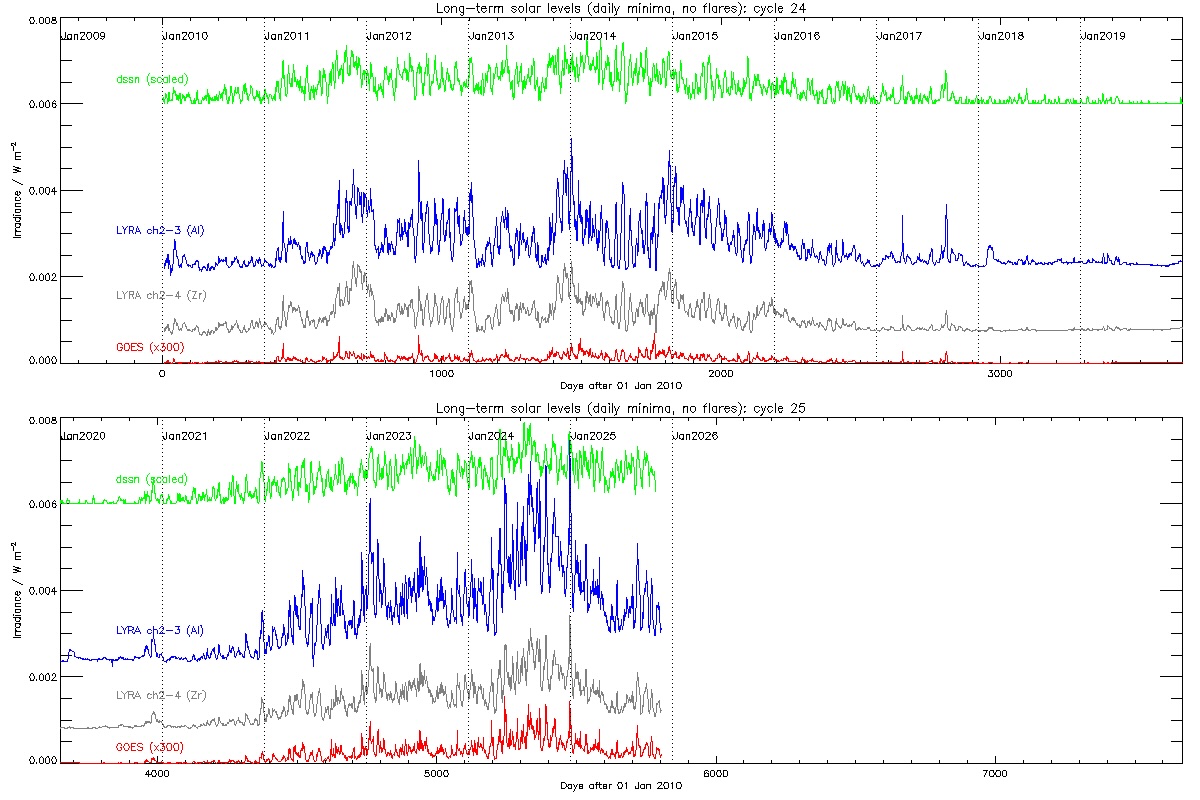
Figure 2
The speakers of the Wetenschapsbattle 2026 are selected
Researchers share their most recent knowledge about spaceweather with thousands of Flemish primary school kids during the Wetenschapsbattle (Battle of Scientists).
On February 6th 2026, two scientists from the STCE will compete for the trophy of most eloquent scientist. Cis Verbeeck and Andreas Debrabandere were selected by the pupils of primary school De Mozaïek in Kessel-Lo.
The Wetenschapsbattle is a project of The Floor is Yours in collaboration with the Solar Terrestrial Centre of Excellence (STCE) and the support of Redwire Space Europe, the KU Leuven and Fonds Wetenschappelijk Onderzoek – Vlaanderen (FWO).
https://wetenschapsbattle.be/editie2026/
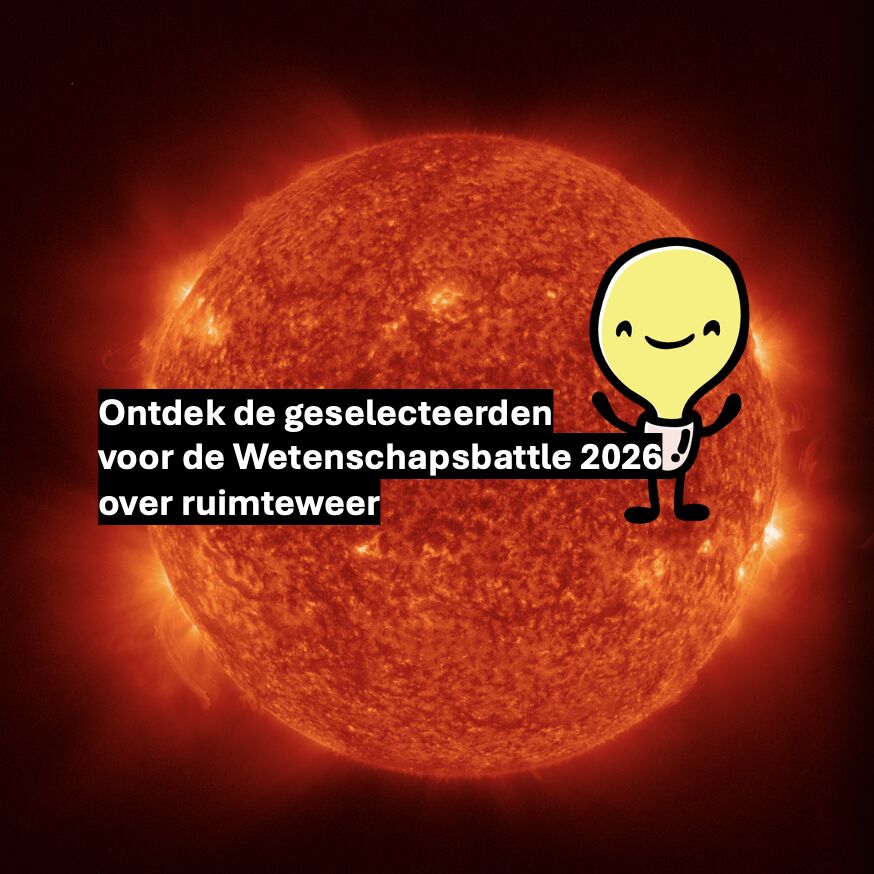
Review of Solar and Geomagnetic Activity
WEEK 1301 from 2025 Dec 01
Solar Active Regions (ARs) and flares
The solar flaring activity over the past week has reached high levels with background C-class flaring, 3 M-class flares and one 1 X-flare. A total of 14 active regions were numbered on the visible solar disk.
The region responsible for the observed high levels of activity is SIDC Sunspot Group 687 (NOAA AR 4299, NOAA AR 4274), which was classified as magnetic type beta-gamma-delta for most of the week. It produced an X1.9 flare (SIDC 6236) with peak time 02:49 UTC on Dec 01, an M1.1 flare (SIDC 6319) with peak time 19:21 UTC on Dec 06 and an M8.1 flare (SIDC 6318) with peak time 20:39 UTC on Dec 06.
An M6.0 flare (SIDC 6285) with peak time at 02:50 UTC on Dec 04 was produced by SIDC Sunspot Group 714 (NOAA AR 4300), which was classified as magnetic type beta-delta that day. Other notable regions throughout the week are SIDC Sunspot Group 709/NOAA AR 4294 and SIDC Sunspot Group 712/NOAA AR 4296, which have grown to become the largest regions on the visible solar disc, and have both been classified as magnetic type beta-gamma-delta on multiple days. Regardless of their complexity, these regions produced only low levels of activity.
Coronal mass ejections
A few noteworthy coronal mass ejections (CMEs) were detected in the coronagraph imagery throughout the week. A fast partial halo CME with an estimated projected velocity of 850 km/s was detected in the LASCO/C2 coronagraph imagery starting at around 03 UTC on Dec 01. The CME was related to the X1.9 flaring activity produced by SIDC Sunspot Group 687 (NOAA AR 4274) at the north-east limb. The CME was directed off the Sun-Earth line and no notable impact on Earth was expected.
A large filament, visible in the SDO/AIA 30.4 nm imagery in the western solar hemisphere, has lifted off the solar surface on the UTC morning of Dec 03, triggering a following eruption a few hours later. A combined slow CME was detected in the LASCO/C2 coronagraph imagery starting at 09:21 UTC on Dec 03, with estimated projected velocity below 400 km/s and a coronal dimming observed around 10:30 UTC. Modelling results suggested that the CME would pass mostly off the Sun-Earth line and have only possible minor glancing blow impacts on Dec 06, but might be mixed within the waning influence of a supposedly ongoing high speed stream.
Another CME detected in the LASCO/C2 imagery starting at 06:36 UTC on Dec 04 following the C4.4 flaring with peak time 05:38 UTC, produced by SIDC Sunspot Group 709 (NOAA Active Region 4294) and related to a coronal dimming first observed at 05:33 UTC, was accompanied by a type IV radio burst registered at 08:32 UTC. The bulk of the CME was expected to miss the Earth with chances for a minor glancing blow mixed within the ambient fast solar wind late on Dec 06 or Dec 07.
A halo CME (SIDC CME 605) was first detected in the LASCO/C2 imagery starting at 19:24 UTC on Dec 06 and visible to the north-east in STEREO at 20:38 UTC. The CME is associated to the M1.1-flaring from SIDC Sunspot Group 687 (NOAA Active Regions 4274, 4299). A consequent faster halo CME was observed after, related to the M8.1 flare from the same region. Associated type II and type IV radio emissions were registered at 20:40 UTC and 20:57 UTC on Dec 06, and a large coronal dimming with post-eruptive arcade was detected in the SDO/AIA imagery as well. The CME was estimated to have a 3D velocity of 850 km/s, with an estimated arrival time early UTC on Dec 09.
Coronal Holes
Two negative polarity coronal holes (SIDC Coronal Holes 140 and 141) were present on the visible disc during the past week. SIDC Coronal Hole 140 was a larger equatorial coronal hole, extending to mid-latitudes to the north. It crossed the central meridian on Nov 30 and an associated high-speed stream emanating from it was expected to arrive at Earth on Dec 03.
Proton flux levels
The greater than 10 MeV GOES proton flux was at nominal levels throughout the entire week with mild enhancements (below 10 pfu radiation storm thresholds) registered on Dec 06 following the M8.1 flaring and related halo CME.
Electron fluxes at GEO
The greater than 2 MeV electron flux as measured by GOES 18 and GOES 19 was exceeding the 1000 pfu threshold for prolonged periods of time on multiple days during the week. The corresponding electron fluence was at moderate levels for most of the week.
Solar wind
The solar wind conditions (as measured by ACE) reflected an anticipated high speed stream (HSS) arrival with a co-rotating interaction region (CIR) detected in the UTC afternoon on Dec 03. The HSS is associated with the recurrent SIDC Coronal Hole 140 (negative polarity), which crossed the central meridian on Nov 30. Related to the CIR/HSS arrival the magnitude of the interplanetary magnetic field (B) reached a maximum value of 22.7 nT on Dec 04, with a minimum Bz of -15.3 nT. The B field phi angle was predominantly in the negative sector (directed towards the Sun) reflecting the polarity of the geo-effective coronal hole (SIDC Coronal Hole 140). The solar wind speed reached a maximum of 771 km/s and remained at high values until the UTC afternoon on Dec 07, when it started to decline towards background slow solar wind conditions.
Geomagnetism
The geomagnetic conditions at the beginning of the week started at quiet to active levels and were predominantly quiet to unsettled on Dec 02. Minor storm levels and an isolated period of major geomagnetic storm were registered on Dec 03 (with NOAA Kp reaching 6.67 between 18:00 to 21:00 UTC) as a consequence of an expected high speed stream arrival. Further minor storm levels were detected on Dec 04. The corresponding geomagnetic conditions locally over Belgium have registered moderate storm levels between 19:00 and 23:00 UTC on Dec 03 and up to active levels there after. Quiet to active geomagnetic conditions were observed from Dec 05 onwards.
International Sunspot Number by SILSO
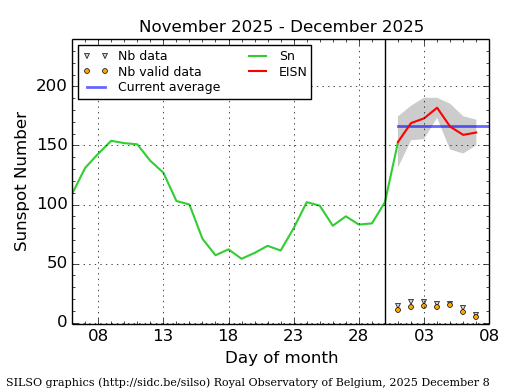
The daily Estimated International Sunspot Number (EISN, red curve with shaded error) derived by a simplified method from real-time data from the worldwide SILSO network. It extends the official Sunspot Number from the full processing of the preceding month (green line), a few days more than one solar rotation. The horizontal blue line shows the current monthly average. The yellow dots give the number of stations that provided valid data. Valid data are used to calculate the EISN. The triangle gives the number of stations providing data. When a triangle and a yellow dot coincide, it means that all the data is used to calculate the EISN of that day.
PROBA2 Observations
Solar Activity
Solar flare activity fluctuated from low to high during the week. In order to view the activity of this week in more detail, we suggest to go to the following website from which all the daily (normal and difference) movies can be accessed: https://proba2.oma.be/ssa
This page also lists the recorded flaring events. A weekly overview movie can be found here (SWAP week 819): https://proba2.sidc.be/swap/data/mpg/movies/weekly_movies/weekly_movie_2025_12_01.mp4
Details about some of this week's events can be found further below.
If any of the linked movies are unavailable they can be found in the P2SC movie repository here: https://proba2.sidc.be/swap/data/mpg/movies/
Monday Dec 01
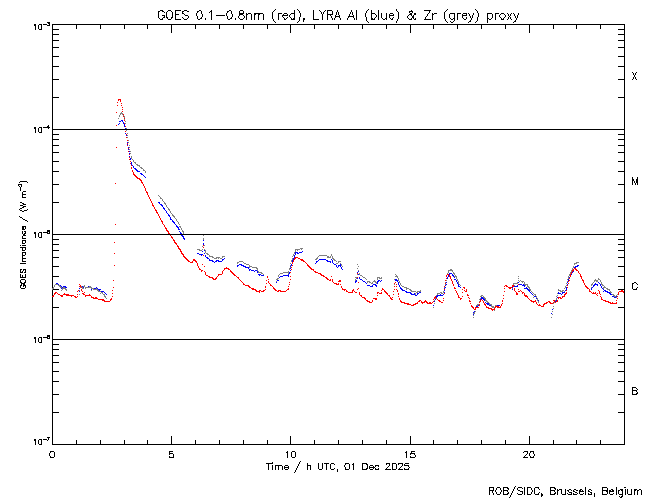

The largest flare of this week was an X1.9, and it was observed by LYRA (top panel) and SWAP (bottom panel). The flare peaked on 2025-Dec-01 at 02:49 UT and occurred on the North East part of the solar disk, originating from active region NOAA4299. Find a SWAP movie of the event here: https://proba2.sidc.be/swap/movies/20251201_swap_movie.mp4
Noticeable Solar Events
| DAY | BEGIN | MAX | END | LOC | XRAY | OP | 10CM | TYPE | Cat | NOAA |
| 01 | 0227 | 0249 | 0305 | N20E81 | X1.9 | 1N | II/2/3I/3 9V/3 | 4299 | ||
| 04 | 0236 | 0250 | 0259 | N6E54 | M6.0 | 1F | II/2 | 26 | 4300 | |
| 06 | 1858 | 1921 | 1936 | N23E8 | M1.1 | 1F | VI/1 | 24 | 4299 | |
| 06 | 2029 | 2039 | 2049 | N21E4 | M8.1 | 2 | V/3II/3 | 24 | 4299 | |
| 07 | 2356 | 0012 | 0023 | M2.4 | 24 | 4299 |
| LOC: approximate heliographic location | TYPE: radio burst type |
| XRAY: X-ray flare class | Cat: Catania sunspot group number |
| OP: optical flare class | NOAA: NOAA active region number |
| 10CM: peak 10 cm radio flux |
Geomagnetic Observations in Belgium

Local K-type magnetic activity index for Belgium based on data from Dourbes (DOU) and Manhay (MAB). Comparing the data from both measurement stations allows to reliably remove outliers from the magnetic data. At the same time the operational service availability is improved: whenever data from one observatory is not available, the single-station index obtained from the other can be used as a fallback system.
Both the two-station index and the single station indices are available here: http://ionosphere.meteo.be/geomagnetism/K_BEL/
Review of Ionospheric Activity


VTEC time series at 3 locations in Europe from 1 Dec 2025 till 7 Dec 2025
The top figure shows the time evolution of the Vertical Total Electron Content (VTEC) (in red) during the last week at three locations:
a) in the northern part of Europe(N 61deg E 5deg)
b) above Brussels(N 50.5deg, E 4.5 deg)
c) in the southern part of Europe(N 36 deg, E 5deg)
This top figure also shows (in grey) the normal ionospheric behaviour expected based on the median VTEC from the 15 previous days.
The time series below shows the VTEC difference (in green) and relative difference (in blue) with respect to the median of the last 15 days in the North, Mid (above Brussels) and South of Europe. It thus illustrates the VTEC deviation from normal quiet behaviour.
The VTEC is expressed in TECu (with TECu=10^16 electrons per square meter) and is directly related to the signal propagation delay due to the ionosphere (in figure: delay on GPS L1 frequency).
The Sun's radiation ionizes the Earth's upper atmosphere, the ionosphere, located from about 60km to 1000km above the Earth's surface.The ionization process in the ionosphere produces ions and free electrons. These electrons perturb the propagation of the GNSS (Global Navigation Satellite System) signals by inducing a so-called ionospheric delay.
See http://stce.be/newsletter/GNSS_final.pdf for some more explanations; for more information, see https://gnss.be/SpaceWeather
The SIDC Space Weather Briefing
The forecaster on duty presented the SIDC briefing that gives an overview of space weather from December 1 to 7.
The pdf of the presentation can be found here: https://www.stce.be/briefings/20251208_SWbriefing.pdf
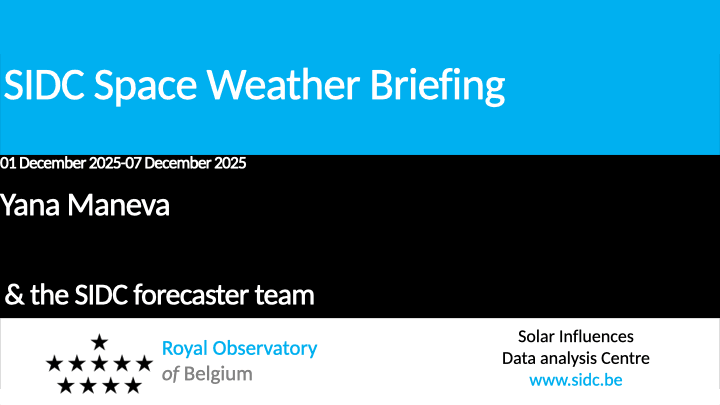
Upcoming Activities
Courses, seminars, presentations and events with the Sun-Space-Earth system and Space Weather as the main theme. We provide occasions to get submerged in our world through educational, informative and instructive activities.
* Feb 9-11, 2026, STCE Space Weather Introductory Course, Brussels, Belgium - register: https://events.spacepole.be/event/255/
* Mar 16-18, 2026, STCE course: Role of the ionosphere and space weather in military communications, Brussels, Belgium - register: https://events.spacepole.be/event/258/
* Apr 20-21, 2026, STCE cursus: inleiding tot het ruimteweer, Brussels, Belgium - register: https://events.spacepole.be/event/260/
* Mar 23, 2026, STCE lecture: From physics to forecasting, Space Weather course, ESA Academy, Redu, Belgium
* Jun 15-17, 2026, STCE Space Weather Introductory Course, Brussels, Belgium - register: https://events.spacepole.be/event/256/
* Oct 12-14, 2026, STCE Space Weather Introductory Course, Brussels, Belgium - register: https://events.spacepole.be/event/257/
* Nov 23-25, 2026, STCE course: Role of the ionosphere and space weather in military communications, Brussels, Belgium - register: https://events.spacepole.be/event/259/
* Dec 7-9, 2026, STCE Space Weather Introductory Course for Aviation, Brussels, Belgium - register: https://events.spacepole.be/event/262/
To register for a course and check the seminar details, navigate to the STCE Space Weather Education Center: https://www.stce.be/SWEC
If you want your event in the STCE newsletter, contact us: stce_coordination at stce.be

Website: https://www.stce.be/SWEC